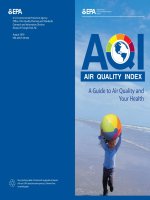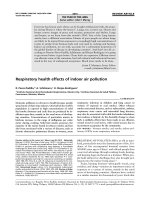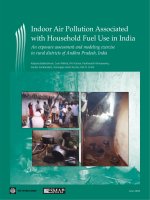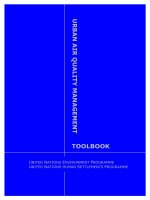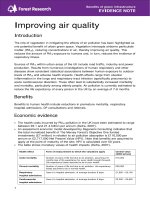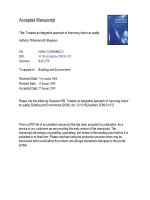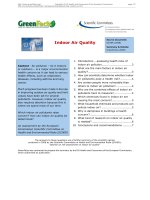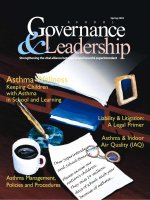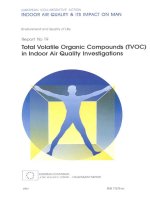Indoor Air Quality doc
Bạn đang xem bản rút gọn của tài liệu. Xem và tải ngay bản đầy đủ của tài liệu tại đây (6.22 MB, 378 trang )
Indoor
Air Quality
The
Latest
Sampling
and
Analytical
Methods
Second EditionCRC Press
Taylor & Francis Group
6000 Broken Sound Parkway NW, Suite 300
Boca Raton, FL 33487-2742
© 2011 by Taylor & Francis Group, LLC
CRC Press is an imprint of Taylor & Francis Group, an Informa business
No claim to original U.S. Government works
Version Date: 2011914
International Standard Book Number-13: 978-1-4398-2666-9 (eBook - PDF)
This book contains information obtained from authentic and highly regarded sources. Reasonable efforts
have been made to publish reliable data and information, but the author and publisher cannot assume
responsibility for the validity of all materials or the consequences of their use. The authors and publishers
have attempted to trace the copyright holders of all material reproduced in this publication and apologize to
copyright holders if permission to publish in this form has not been obtained. If any copyright material has
not been acknowledged please write and let us know so we may rectify in any future reprint.
Except as permitted under U.S. Copyright Law, no part of this book may be reprinted, reproduced, transmit-
ted, or utilized in any form by any electronic, mechanical, or other means, now known or hereafter invented,
including photocopying, microfilming, and recording, or in any information storage or retrieval system,
without written permission from the publishers.
For permission to photocopy or use material electronically from this work, please access www.copyright.
com ( or contact the Copyright Clearance Center, Inc. (CCC), 222 Rosewood
Drive, Danvers, MA 01923, 978-750-8400. CCC is a not-for-profit organization that provides licenses and
registration for a variety of users. For organizations that have been granted a photocopy license by the CCC,
a separate system of payment has been arranged.
Trademark Notice: Product or corporate names may be trademarks or registered trademarks, and are used
only for identification and explanation without intent to infringe.
Visit the Taylor & Francis Web site at
and the CRC Press Web site at
v
Contents
Preface xv
Acknowledgments xvii
About the Author xix
Section I The Starting Line
1. Historic Overview 3
Evolution of Indoor Air Quality Investigations 3
Litigation 5
Differences in Health Effects 6
A Misguided Premise 7
Regulations, Requirements, and Guidelines 7
U.S. Government Directives 8
EPA National Ambient Air Quality Standards 8
OSHA Workplace Standards 9
ACGIH Workplace Guidelines 10
ASHRAE Criteria for General Public 10
ACGIH Guidelines Revisited in Older ASHRAE Standard 11
International Enforcement and/or Guidelines 12
ASHRAE Criteria for Residences 12
ASHRAE Criteria for High Performance Buildings 12
Summary 13
References 13
2. Investigation Plan 15
Documents Review 17
Building a Walk-Through 18
Occupied Areas 18
Air Handling System 19
Bathroom Air Exhaust 20
Sewer System 21
Occupant Activities 21
Interviews with Facilities Personnel 21
Maintenance Staff 21
Custodial Staff 22
Observation of Surrounding Areas 23
Assessing Occupant Complaints 23
Questionnaires 24
vi Contents
Types of Questionnaires 24
Questionnaire Response Rate 24
Informational Data 25
Interviews 27
Summary 27
References 27
3. The Hypothesis 29
Information Review 30
Building Assessment 30
Complaint Occupant 31
Hypothesis Development 34
The Proactive Approach 36
Beyond the Scope 37
Medical Physicians 37
Industrial Hygienists and Toxicologists 38
Psychiatrists 38
Summary 39
References 39
Section II Omnipresent Bioaerosols
4. Pollen and Spore Allergens 43
Occurrence of Pollen and Spore Allergens 43
General Information 44
Spore-Producing Fungi and Bacteria 49
Fungi 49
Molds 49
Mushrooms 52
Rusts and Smuts 53
Slime Molds 54
Bacteria 55
Indoor Source Information 55
Sampling Strategy 56
Sampling and Analytical Methodologies 57
Slit-to-Cover-Slip Sample Cassettes 57
Slit-to-Slide Samplers 58
Analytical Methods 59
Commercial Laboratories 59
Helpful Hints 59
Interpretation of Results 60
Summary 66
References 66
Contents vii
5. Viable Microbial Allergens 67
Occurrence of Allergenic Microbes 67
Fungi 68
Molds 68
Yeasts 72
Bacteria 72
Bacillus 73
Thermophilic Actinomycetes 74
Air Sampling Methodologies 74
Sampling Strategy 75
When and Where to Sample 75
Equipment 76
Sample Duration 78
Sample Numbers 78
Culture Media 79
Procedural Summary 83
Diagnostic Sampling Methodologies 83
Sampling Strategy 84
Where to Sample 84
What to Sample 85
Sampling Supplies 85
Procedural Summary 86
Interpretation of Results 86
Genus Variability 87
Airborne Exposure Levels 89
Bulk and Surface Sample Results 89
Helpful Hints 90
Summary 90
References 91
6. Pathogenic Microbes 93
Airborne Pathogenic Fungi 94
Disease and Occurrence 94
Aspergillus 94
Histoplasma capsulatum 96
Coccidioides immitis 97
Cryptococcus neoformans 99
Other Pathogenic Fungi 99
Sampling and Analytical Methodologies 102
Interpretation of Results 103
Airborne Pathogenic Bacteria 103
Pathogenic Legionella 104
Sampling and Analytical Methodologies for Legionella 105
Interpretation of Results 106
Helpful Hints 107
viii Contents
Other Pathogenic Bacteria 108
Disease and Occurrence of Prominent Airborne Pathogenic
Bacteria 108
Sampling and Analytical Methodologies 111
Interpretation of Results 112
Pathogenic Protozoa 113
Sampling and Analytical Methodology 113
Interpretation of Results 114
Viruses 114
Summary 115
References 115
7. Toxigenic Microbes 119
Mycotoxins 119
Disease and Occurrence 121
Sampling and Analytical Methodologies 123
Fungi Identication 123
Toxin Identication 124
Interpretation of Results 126
Bacterial Endotoxins 127
Sampling and Analytical Methodology 128
Interpretation of Results 130
Summary 131
References 131
Section III Chemical Unknowns and Gases
8. Volatile Organic Compounds 135
Health Effects and Occurrences 136
Air Sampling Strategy 139
When to Sample 139
Where to Sample 140
How to Sample 141
Rationale for Total VOC Screening (As Opposed to Component
Identication) 141
Air Sampling and Analytical Methodologies 143
Solid Sorbents and Air Sampling Pumps 145
NIOSH Method 1500 145
EPA Method TO-17 147
Passive Organic Vapor Monitors 149
Evacuated Ambient Air Containers 151
Whole Air Canisters 152
Ambient Air Sampling Bags 154
Contents ix
Analytical Comparisons 156
Helpful Hints 158
Interpretation of Results 159
Summary 161
References 161
9. Mold Volatile Organic Compounds and Mold Detection 163
Health Effects and Occurrences 163
Sampling for MVOCs 166
Sampling Strategy 166
Sampling Methodology 167
Screening Methodologies 168
Visual Observations 168
Odor Tracking 170
Moisture Testing 171
Interpretation of Results 173
Summary 174
References 174
10. Carbon Dioxide 177
Occurrence of Carbon Dioxide 178
Sampling Strategy 179
Sampling Methodologies 180
Direct Reading Instrumentation 180
Colorimetric Detectors 180
Helpful Hints 182
Interpretation of Results 183
Summary 184
11. Carbon Monoxide 185
Occurrence of Carbon Monoxide 185
Sampling Strategy 187
Sampling Methodologies 188
Direct Reading Instrumentation 188
Colorimetric Detectors 188
Helpful Hints 190
Interpretation of Results 190
Summary 191
Reference 191
12. Formaldehyde 193
Occurrence of Formaldehyde 194
Sampling Strategy 196
Sampling Methodologies 197
Analytical Methodologies 201
x Contents
Helpful Hints 202
Interpretation of Results 202
Summary 203
References 203
13. Product Emissions 205
Global Response and Product Labelling 206
Product Emissions Awareness 208
Sensory Irritation Testing in Environmental Chambers 211
Product Collection 212
Environmental Chamber and Analytical Methodology 216
Measurements of Product Emission Factors 219
Interpretation of Results 220
Summary 223
References 225
Section IV Identification of Dusts
14. Forensics of Dust 229
Occurrences of Forensic Dust 230
Sampling Methodologies 232
Settled Surface Dust Sampling 234
Specialty Tape 234
Clear Tape 235
Post-it Paper 235
Micro-vacuuming 235
Airborne Dust Sampling 236
Spore Trap 236
Membrane Filters 237
Cascade Impactors 238
Other Methods 238
Bulk Sampling 239
Textile/Carpet Sampling 239
Analytical Methodologies 240
Visible Light Microscopy 240
Specialized Microscopic Techniques 241
X-Ray Diffraction 241
Scanning Electron Microscope 242
Transmission Electron Microscope 243
Electron Microprobe Analyzer 244
Ion Microprobe Analyzer 244
Commercial Laboratories 245
Summary 245
References 246
Contents xi
15. Animal Allergenic Dust 247
Animal Allergens 248
Mites/Spiders 248
Booklice 251
Cockroaches and Other Insects 251
Domestic Animals 254
Cats 255
Dogs 255
Rodents 256
Farm Animals 257
Other Animals 257
Occurrence of Animal Allergens 257
Sampling Strategy 258
Screening for Rodents 260
Sampling Methodologies 260
Analytical Methodologies 263
Human Testing 263
Allergenic Dust Testing 264
Interpretation of Results 265
Other Types of Allergenic Substances 268
Summary 269
References 270
Section V Building Systems and Materials
16. HVAC Systems 275
The Basic Design 275
HVAC Visual Inspection 278
Outdoor Air Intake 278
Outdoor Air in the Vicinity of Air Intake 279
Indoor HVAC Equipment Rooms 279
Filters 279
Condensate Drain Pan 282
Fan Housing 284
Unit and Duct Liner 284
Supply Registers and Return Air Grills 286
Level of Maintenance 288
Air Duct 289
Strategy and Sampling 290
Analyzing the Unknown 292
Interpretation Not So Simple 292
Summary 293
xii Contents
17. Sewage Systems and Sewer Gases 295
Occurrence of Sewer Gases 296
Hazardous Gases 296
Biological Components 297
Noxious Odor Confusion 297
Investigation Procedures 298
Air Sampling 299
Identication of Components 299
Tracking Sewer Gases 299
Sewage System Inspection Awareness 300
Poorly Installed Sewer Vents 300
Plumbing Fixtures and Associated Traps 301
In-Foundation Line Breaks 301
Septic/Sewage Drains and Lines 302
Interpretation of Results 302
Summary 303
18. Tainted Chinese Drywall 305
Health Effects 306
Screening Considerations 308
Homeowner Assessment 308
Inspection Screening 308
Components of Chinese Drywall 309
Sampling and Analytical Methodologies 311
Bulk Sample Collection and Analysis forIdentication
ofChinese Drywall 311
Sample Collection 311
Sample Analysis 312
Suspect Air and Headspace Sampling for Off-Gassing
Components 313
Sample Collection 313
Sample Analyses 314
Corrosion Testing 315
Sample Collection 315
Microbiological Testing 316
Interpretation of Results 317
Chinese Manufactured Drywall 317
Off-Gassing Sulfur-Containing Gases 317
Causes Corrosion 318
Summary 318
References 319
19. Green Buildings 321
21st Century Green 322
Green Flush-Out Protocols 323
Contents xiii
LEED Indoor Air Quality Management Plan 324
ANSI/ASHRAE Standard 189.1—Construction and Plans
forOperation 324
Sampling and Analytical Methodologies 325
Interpretation of Results 331
Summary 334
References 334
Glossary 335
Appendix A: Abbreviations/Acronyms 345
Appendix B: Units of Measurement 347
Appendix C: Allergy Symptoms 349
Appendix D: Classication Volatile Organic Compounds 353
xv
Preface
With the new millennium comes change. Indoor air quality methodologies
have expanded, evolved, and morphed. The focus is shifting from a knee-jerk
to a more proactive response. Although indoor air quality in older buildings
will continue to present old challenges, new construction is going forward
with new challenges.
The intent of this book is to provide environmental professionals, indus-
trial hygienists, and indoor air quality specialists with the latest and great-
est methods in response to the knee-jerk indoor air quality challenges and
for assessing new construction prior to occupancy. The focus is to provide
a “practical guide” for developing a theory and following it through to the
identication and interpretation of unknown air contaminants.
Section I, “The Starting Line,” provides a historic overview with regulatory
limits and guidelines; preliminary investigation methods including means
for assessing complaints; and a means for speculation, narrowing the hunt
for offenders. With a well-dened hypothesis, the investigator must test the
hypothesis by sampling. Direction is provided for determining what, when,
where, and how to sample for the various airborne components that may
be found in indoor air quality situations. The components are broken into
bioaerosols, chemicals, and dust.
Section II, “Omnipresent Bioaerosols,” is inclusive of microbials only. This
section discusses sampling methodologies for microbial allergens such as fungi
and pollen; invasive pathogenic microbes; and toxigenic molds/bacteria. Other
biological components such as animal allergens are contained within another
section.
Section III, “Chemical Unknowns and Gases,” contains sampling methodol-
ogies for volatile organic compounds; microbial volatile organic compounds;
carbon dioxide; carbon monoxide; formaldehyde; and product emissions.
The microbial volatile organic compounds are discussed within this section
because some researchers speculate that microbial (e.g., mold) by-products
may contribute to the total volatile organic compounds in an enclosed build-
ing. Yet some use the techniques to locate mold in wall spaces.
Section IV, “Identication of Dusts,” contains sampling methodologies for
animal allergens such as dust mites and forensic methods for identifying
dust components. Dust components can be checked for chemicals adsorbed
onto or settled on the surface of dust particles, toxic metals, and various
types of bers (e.g., resin-coated berglass).
Section V, “Building Systems and Materials,” is a new section. Often over-
looked and underutilized, sewage gases and HVAC systems are discussed
and assessment guidelines provided. The topic of tainted Chinese drywall
has become a bucket of worms—legally, nancially, and analytically. In the
xvi Preface
chapter “Tainted Chinese Drywall,” the background information and more
prominent sampling methodologies are discussed. The last chapter is “Green
Buildings.” The concept of green buildings has shifted from resource con-
servation only to resource conservation and healthy indoor air quality. The
Leadership in Energy and Environmental Design (LEED) Rating System and
American Society of Heating, Refrigerating and Air Conditioning Engineers
(ASHRAE) 189.1 are discussed, and air sampling methodologies and sample
limits are detailed.
As a passion for detective work is a delightful motivator for performing an
indoor air quality assessment, the person performing such a survey is herein
referred to as the “investigator.” The investigator’s greatest asset is his or her
ability to weave through a convoluted web of complex problems. This book
provides strategies and tools to herald Sherlock Holmes!
xvii
Acknowledgments
I wish to dedicate this book to those who have contributed their time and
technical expertise to review and update technical information that is
constantly changing. A special thanks to Sean Abbott, PhD, mycologist
extraordinaire and director of Natural Link Mold Lab, for reviewing the
extensive section on bioaerosols. Paul Pope, MS, analytical chemist for ALS
Laboratory Group, made whole the table on EPA air monitoring method-
ologies, reviewed “Green Buildings”, and shared his company’s unique
ndings regarding tainted Chinese drywall. He truly has been an invalu-
able resource of all information—established and evolving. Vince Delessio
with EMSL provided information regarding tainted Chinese drywall as
well, and Marilyn Black, PhD, with Air Quality Services reviewed the
evolving chapter on “Product Emissions.” Each of these contributors has
been patient, withstanding my endless questions and ceaseless requests
for data.
Last, but certainly not least, my husband has been my rock of sanity in
the nal throes of a topic that changes daily. As my dog runs in circles, the
house is in disarray, and the world races on, I offer my gratitude and heartfelt
thanks to all!
xix
About the Author
Kathleen Hess-Kosa is the president/owner of Omega Southwest Enviro-
nmental Consulting. In 1972, she received her bachelor of science degree in
microbiology with a minor in chemistry from Oklahoma State University.
After serving as an ofcer in the Air Force for three years, she returned to
school and earned a master of science degree (1979) in industrial hygiene
from the College of Engineering at Texas A&M University. Her research
involved an animal toxicological study and was conducted at the College
of Veterinary Sciences.
Hess-Kosa worked as a consultant forFiremen’s Fund Insurance Companies
until 1984. This was shortly after she passed the certication exam conducted
by the American Board of Industrial Hygiene. During these ve years,
Hess-Kosa had the opportunity to become involved in a variety of unique
industrial hygiene and environmental concerns, including indoor air qual-
ity concerns in an 800-occupant ofce building and information gathering
for performing environmental site assessments and assessing waste. All this
and much more carried over to her private consulting business.
Hess-Kosa has since conducted numerous Phase I environmental site
assessments and published a book concerning the topic. She has actively
pursued obscure sources of information and training to better address the
complex nature of environmental issues, indoor air quality, and multiple
chemical sensitivity. She has successfully identied sources of indoor air
quality problems in more than 90 percent of the numerous investigations
performed, and she has been instrumental in rectifying 100 percent of the
scenarios. It took some time to get to this point, but some of the information
that was collected and has been used by Hess-Kosa is presented within this
book.
Section I
The Starting Line
3
1
Historic Overview
An estimated 1.34 million ofce buildings have problems with air qual-
ity, and approximately 30 percent of all ofce employees are potentially
exposed to the health effects of poor indoor air quality.
1
More than 50 million
Americans suffer from asthma, allergies, and hay fever. Chronic bronchitis
and emphysema increased by more than 85 percent between 1970 and 1987.
Close to 100,000 Americans die each year because of complications due to
chronic obstructive pulmonary diseases (COPD).
1
More than 50 percent of
our nation’s schools have poor ventilation and signicant sources of pollu-
tion in buildings, where an estimated 55 million students and school staff
members are affected by poor air quality. Health effects are predominantly
observed in children with asthma. In the last 15 years, a 60 percent increase
in the incidence of asthma has occurred amongst school-aged children.
Today approximately 8 percent of all school-aged children have been diag-
nosed with asthma.
In an effort to address many of the prevailing and ever-looming issues,
indoor air quality investigative methodologies are evolving. Indoor air qual-
ity is complex!
Many indoor air quality situations culminate with litigation, differences in
health impact, differences in perceived health effects, regulatory limits, and
guidelines. Guidelines are being created by recognized public agencies, and
investigators are being called upon to make decisions with minimal support
and direction. Finally, indoor air quality investigations are becoming more
proactive, part and parcel of the new “healthy” green buildings.
Evolution of Indoor Air Quality Investigations
The Environmental Protection Agency (EPA) ranks indoor air pollution
among the top four environmental risks in America. People spend about
90 percent of their lives indoors, and pollution is consistently two to ve
times higher indoors than outdoors. The indoor pollutant levels have been
reported as high as 100 times the levels encountered outside.
Since the worldwide energy crisis in 1973, advances in energy efciency
building construction have not been without a downside. In an effort to
conserve fuel in commercial and residential buildings, builders started
4 Indoor Air Quality: The Latest Sampling and Analytical Methods
constructing airtight buildings, inoperable airtight windows, and reduced
air exchange rates.
In well-weatherized homes, the air exchange rate is 0.2 to 0.3 air changes
per hour. In older, less energy efcient homes, exchange rates are as high as
2 changes per hour. In energy efcient ofce buildings, air exchange rates
are around 0.29 to 1.73 changes per hour. The higher exchange rates in older
buildings dilute and clean indoor air contaminants, whereas the newer
buildings retain them. Thus, illness associated with new buildings has come
to be referred to as “tight building syndrome.”
By 1986 the news media began to sensationalize the condition and coined
the term “sick building syndrome.” Sick building syndrome is a condition
whereby the occupants of a building experience health and comfort prob-
lems that seem to be linked to a building, and the cause is unknown. Indoor
air quality investigative methods to identify unknown sources of building-
related health complaints have continued to evolve.
At the low end of the evolutionary scale, formaldehyde off-gassing from
furnishings in ofce buildings and from particleboard in mobile homes was
targeted as the single most investigated culprit. One article, published in 1987,
refers to formaldehyde as a “deadly sin.” New media touted, “It Could Be
Your Ofce That Is Sick,” “Tight Homes, Bad Air,” and “The Enemy Within.”
Sensational! Insurance claims were on the rise, and insurance companies began
to exclude “claims arising directly or indirectly out of formaldehyde whether or
not the formaldehyde is airborne as a ber or particle, contained in a product,
carried or transmitted on clothing contained in or a part of any building, build-
ing material, insulation product or any component part of any building.”
With the passage of time it became clear that the problem was not a sim-
ple one, and looking for unknowns was not a simple process. As industrial
hygienists scrambled to identify other possibilities, ofce building investi-
gations became research projects. The cost was in the thousands of dollars.
Ongoing complaints recurred, and ultimately the industrial hygiene profes-
sion pioneered the investigative and sampling methodologies that are in
play today.
The original hit list evolved to include not only formaldehyde but car-
bon monoxide, carbon dioxide (fresh air/indicator gas), and total organics.
Industrial hygienists further attempted to identify volatile organic com-
pounds (VOC). Many began looking at carpet emissions (e.g., 4-phenylcy-
clohexene), tobacco smoke, and airborne/surface allergens. All things were
possible. All possibilities were “open for discussion.”
In the latter part of the 20th century, residential concerns were being
addressed with greater frequency. Considerations for sampling included
formaldehyde, carbon monoxide, carbon dioxide, allergens, electromagnetic
radiation, radon, and a medley of household products (e.g., VOC).
By 2000, mold became the new “hot topic.” The focus shifted from formal-
dehyde and other chemicals to mold. Media headlines heralded, “The Dish
on Hotel Air,” “Moldy Attitudes on Indoor Air Need a Good Scrubbing,”

